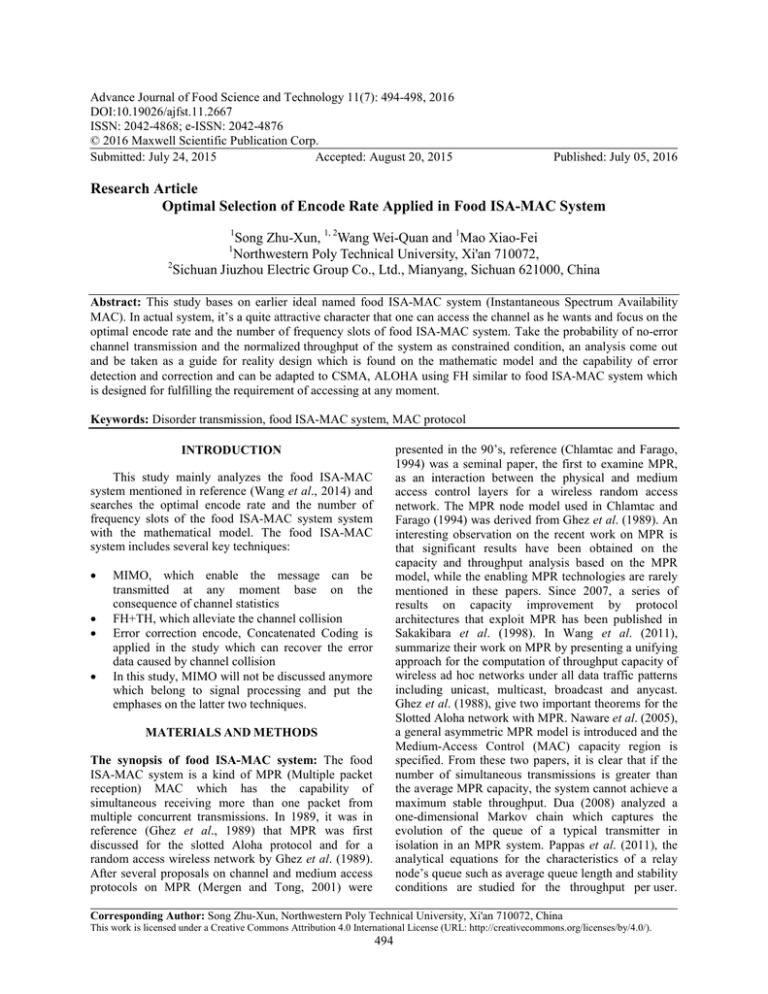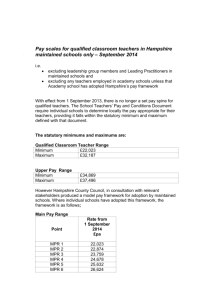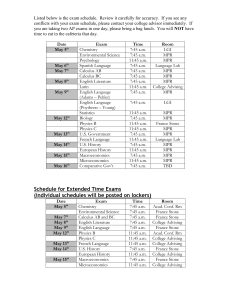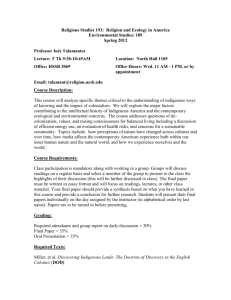Advance Journal of Food Science and Technology 11(7): 494-498, 2016 DOI:10.19026/ajfst.11.2667
advertisement

Advance Journal of Food Science and Technology 11(7): 494-498, 2016 DOI:10.19026/ajfst.11.2667 ISSN: 2042-4868; e-ISSN: 2042-4876 © 2016 Maxwell Scientific Publication Corp. Submitted: July 24, 2015 Accepted: August 20, 2015 Published: July 05, 2016 Research Article Optimal Selection of Encode Rate Applied in Food ISA-MAC System 1 Song Zhu-Xun, 1, 2Wang Wei-Quan and 1Mao Xiao-Fei Northwestern Poly Technical University, Xi'an 710072, 2 Sichuan Jiuzhou Electric Group Co., Ltd., Mianyang, Sichuan 621000, China 1 Abstract: This study bases on earlier ideal named food ISA-MAC system (Instantaneous Spectrum Availability MAC). In actual system, it’s a quite attractive character that one can access the channel as he wants and focus on the optimal encode rate and the number of frequency slots of food ISA-MAC system. Take the probability of no-error channel transmission and the normalized throughput of the system as constrained condition, an analysis come out and be taken as a guide for reality design which is found on the mathematic model and the capability of error detection and correction and can be adapted to CSMA, ALOHA using FH similar to food ISA-MAC system which is designed for fulfilling the requirement of accessing at any moment. Keywords: Disorder transmission, food ISA-MAC system, MAC protocol presented in the 90’s, reference (Chlamtac and Farago, 1994) was a seminal paper, the first to examine MPR, as an interaction between the physical and medium access control layers for a wireless random access network. The MPR node model used in Chlamtac and Farago (1994) was derived from Ghez et al. (1989). An interesting observation on the recent work on MPR is that significant results have been obtained on the capacity and throughput analysis based on the MPR model, while the enabling MPR technologies are rarely mentioned in these papers. Since 2007, a series of results on capacity improvement by protocol architectures that exploit MPR has been published in Sakakibara et al. (1998). In Wang et al. (2011), summarize their work on MPR by presenting a unifying approach for the computation of throughput capacity of wireless ad hoc networks under all data traffic patterns including unicast, multicast, broadcast and anycast. Ghez et al. (1988), give two important theorems for the Slotted Aloha network with MPR. Naware et al. (2005), a general asymmetric MPR model is introduced and the Medium-Access Control (MAC) capacity region is specified. From these two papers, it is clear that if the number of simultaneous transmissions is greater than the average MPR capacity, the system cannot achieve a maximum stable throughput. Dua (2008) analyzed a one-dimensional Markov chain which captures the evolution of the queue of a typical transmitter in isolation in an MPR system. Pappas et al. (2011), the analytical equations for the characteristics of a relay node’s queue such as average queue length and stability conditions are studied for the throughput per user. INTRODUCTION This study mainly analyzes the food ISA-MAC system mentioned in reference (Wang et al., 2014) and searches the optimal encode rate and the number of frequency slots of the food ISA-MAC system system with the mathematical model. The food ISA-MAC system includes several key techniques: • • • • MIMO, which enable the message can be transmitted at any moment base on the consequence of channel statistics FH+TH, which alleviate the channel collision Error correction encode, Concatenated Coding is applied in the study which can recover the error data caused by channel collision In this study, MIMO will not be discussed anymore which belong to signal processing and put the emphases on the latter two techniques. MATERIALS AND METHODS The synopsis of food ISA-MAC system: The food ISA-MAC system is a kind of MPR (Multiple packet reception) MAC which has the capability of simultaneous receiving more than one packet from multiple concurrent transmissions. In 1989, it was in reference (Ghez et al., 1989) that MPR was first discussed for the slotted Aloha protocol and for a random access wireless network by Ghez et al. (1989). After several proposals on channel and medium access protocols on MPR (Mergen and Tong, 2001) were Corresponding Author: Song Zhu-Xun, Northwestern Poly Technical University, Xi'an 710072, China This work is licensed under a Creative Commons Attribution 4.0 International License (URL: http://creativecommons.org/licenses/by/4.0/). 494 multiple-reception communication RF channel. Prior to transmission, the system terminal checks the status of channel according to the channel statistical result from multiple-receivers which will monitor the channel during idle and make sure if there is some margin for certain priority message to transmit, communication capability is limited by upper capability which will lead to communication collapse if it is exceeded, so only a certain amount of transmission exists at an instantaneous moment. The specific processing of transmission is shown in flow chart (Fig. 1). RESULTS AND DISCUSSION Adv. J. Food Sci. Technol., 11(7): 494-498, 2016 The characters of food ISA-MAC system include: • • • • Fig. 1: Food ISA-MAC system protocol flow chart There are a number of techniques which allow simultaneous decoding of packets on a receiver but in many papers MPR is said to be realized with CDMA or MIMO. Moraes et al. (2007), the authors describe a many-to-many communication in which the transmissions are divided in frequency to allow the receiver to decode the packets. Van der Veen and Tong (2002), the authors present Known Modulus Algorithms (KMA) to allow packet separation in asynchronous ad hoc networks. Wu et al. (2008), a variation of KMA, Algebraic KMA (AKMA), is proposed based on a matrix perturbation analysis. Other signal separation techniques based on a Constant Modulus Algorithm (CMA) or Multiple Modulus Algorithm (MMA) requires blind equalization and are usually not efficient for MPR. Speak of MAC with MPR, in Tong et al. (2001) and Mergen and Tong (2001) proposed a multiple-access protocol based on Receiver Controlled Transmission (RCT). RCT is a hybrid scheduled and random access MAC, which applies scheduling to determine the receiving nodes and then the transmitters for each receiving node. RCT aims to maximize local throughput by granting an appropriate subset of users so that the varying levels of MPR capability are exploited. The main idea of food ISA-MAC system protocol is described as follows: In the system, communication channel and quantity present diversity states. To satisfy the requirement for time-sensitive, the information is divided into several categories which takes different transmission priority refers to the degree of time sensitive. In fact, the system terminal equips with one transmission RF channel and The message can be sent as it need only if the channel is not saturated By means of controlling the volume of business of channel, the total of business could keep stable level If the volume of business increase, it is helpful to keep The first successful delivery probability by postponing or decreasing the lower priority message Provide highest throughput for the higher priority message. Food ISA-MAC system protocol aims at the goal to satisfy system users with the high probability of first successful delivery under the appropriate network burden. MATHEMATIC MODEL AND THEORY ANALYSIS The communication model adapted by food ISAMAC system refers to the reference (Ghez et al., 1989), as a depiction in Fig. 2. Given that there exist T users in the system, they can easily communicate with one transmitter and multiple receivers, which is a mechanism of avoiding the failure caused by collision even if no appointment and coordination. If the message need be sent out, it will be encoded with the Concatenated Code at first and accompany scrambling and interleaving etc. processing technique to depress BER. Besides, the system utilizes a combination of FH-TH spread spectrum mode to gain the two benefits: first, FH-TH could be regarded as a space diversity technology and bring the processing gain; second, FH-TH could reduce the collision probability and improve the probability of first successful delivery. Because of FH-TH, the system modulation should adopt the constant envelope modulation technology in case of emergence of the signal leakage problem. More discussions concern the Concatenated Code could be found in reference (Wang et al., 2014) and would not be described any more. 495 Adv. J. Food Sci. Technol., 11(7): 494-498, 2016 Fig. 2: The communication model of food ISA-MAC system Fig. 3: Schematic diagram of concatenated coding The optimal rate of code: Assume P presents the number of frequency slots, which means there are P parallel, contention free frequency slots at any time. But it is not hard to imagine that there will be a "collision" if multiple users occupy the same frequency point transmission. In fact, asynchronous frequency hopping is much easier to realize than synchronous frequency hopping because the Time synchronization is very difficult in a large scale scene, so asynchronous frequency hopping is adopted in reference (Wang et al., 2014) advisedly. In reference (Wang et al., 2014), the probability of collision in the asynchronous FH model is shown: ph = In which, r = l/n, R = L/N presents the rate of the out code and the rate of the inner code respectively (Fig. 3). To simplify the analysis condition, each hop contains an inner symbol, which is composed of outer code splited after scrambling. In terms of channel, it’s necessary to analyze the inner code and introduce the characteristics of the out code in the process of analysis. Set e as the inner error correcting capability, f represents the inner Error detection capability (e≤f) and meet the conditions: e + f < dmin, dmin is the minimum hamming distance of the inner code. When errors occur during transmission, if detected, then the symbol will be erased, however, if the errors are not detected, nor corrected, then the inner code will output error symbol. Set pd and pud as the error detection probability and the error detection probability respectively, the out code have the capability to correct and erasure the output error symbol from the inner code. 1 1 (2 − ) p p Assume Q presents the number of active users, Q<T, T presents the number of total system users, which means the presence of Q instantaneous transmission at the same time and the probability of system collision is: Think in frequency slot: According to reference (Kim and Stark, 1989), the general throughput can be defined as: phit = 1 − (1 − ph )Q −1 System deploys the Concatenated Code, in which the out code is (n, l), the inner code is (N, L), the rate of Concatenated Code is: W= r ' KPC q In which, r' is the rate of Concatenated Code, K is the quantity of active users, Pc is the probability of no rR = lL nN 496 Adv. J. Food Sci. Technol., 11(7): 494-498, 2016 Table 1: The statistical results for optimal rate Serial number Inner code Out code 1 RS (31, 15) RS (255, 239) 2 RS (31, 15) RS (255, 127) 3 RS (15, 7) RS (255, 127) 4 RS (31, 15) RS (511, 255) 5 RS (31, 15) RS (1023, 511) 6 RS (31, 15) RS (2047, 1023) 7 RS (15, 7) RS (2047, 1023) pd 0.0014 0.0165 0.00061 0.00061 8.7261e-07 1.7301e-12 2.5519e-25 error transmission, q is the quantity of frequency slots. The derivation processing is not noticed any more; take the related parameters Into the Mentioned equation: W= Pud 1.3574e-81 8.4839e-82 1.2995e-38 1.5271e-81 2.8845e-81 5.5994e-81 9.9631e-38 α 3.9 3.9 3.9 3.9 3.9 3.9 3.9 rR 0.9373 0.4980 0.4980 0.4990 0.4995 0.4998 0.4998 It’s easy to choose the optimal combination of code: RS (31, 15) as inner code, RS (255,127) as out code for two reasons: first, pd is relatively high; second, the efficiency of encoding is high. l L KPC • • n N q CONCLUSION The conclusion could be summarized: Set the rate of the out code as a constant, therefore: The simulation and verification: The protocol is analyzed and stimulated with MATLAB and the statistical results are as follows: According to the above analysis, α = F −1 (1 − PE ) Promoting the rate of out code is helpful to improve the throughput of systems It works to reduce q to improve the throughput of system when the rate of out code is fixed to some extent over which the rule will be invalid, for example W>1 (W is a normalized parameters and can’t exceed 1). It have been proved in the existing literature that the threshold of normalized throughput of async-FH is e-1 and choose the value of q to achieve the throughput close to e-1, such as 20, 15 or 13. and to realize no error PE 1 − Pc ( I ) ≤ PE , communication, Pc(I) have to be 1 that led PE to be 0, α take value 3.9 by looking up the standard normal distribution table. The content of Table 1 is part of the testing data which provide the consult as follows: In this section the paper focus on the analysis for searching the optimal rate and frequency slot by mathematic model which is validated with Matlab that the theoretical analysis could be utilized to optimize the code type of RS-RS Concatenated Code and the frequency slot. lim W = n →∞ • L K (1 − pd − pud ) • N q • Which gains the appropriate quantity of frequency slots by approaching maximum network throughput. • • • • The rate of system is effected by the rate of out code mainly, if the rate of out code is larger, the rate of system will be larger which imply higher code efficiency and poorer error correction and detection capability When the rate of out code reach certain level, the rate of system will trend to be stable, it’s proved to be limited that improve the system by increasing the rate of out code. If the rate of inner code and the rate of out code are all tend to be 0.5. The rate of system will close to be 0.5, but never be 0.5. It’s the proper combination to ensure the system gain best error correction capability and error detection capability. In the algorithm, information is encoded by super long code before being divided into short information which is encoded by short code. Through the way, system gains the stronger decoding capability to recover system information even if a large number of short codes improve the probability of collision. REFERENCES Chlamtac, I. and A. Farago, 1994. An optimal channel access protocol with multiple reception capacity. IEEE T. Comput., 43(4): 480-484. Dua, A., 2008. Random access with multi-packet reception. IEEE T. Wirel. Commun., 7(6): 2280-2288. Ghez, S., S. Verdú and S.C. Schwartz, 1988. Stability properties of slotted Aloha with multipacket reception capability. IEEE T. Automat. Contr., 33(7): 640-649. Ghez, S., S. Verdu and S.C. Schwartz, 1989. Optimal decentralized control in the random access multipacket channel. IEEE T. Automat. Contr., 34(11): 1153-1163. Kim, S.W. and W. Stark, 1989. Optimum rate ReedSolomon codes for frequency-hopped spreadspectrum multiple-access communication systems. IEEE T. Commun., 37: 138-144. 497 Adv. J. Food Sci. Technol., 11(7): 494-498, 2016 Mergen, G. and L. Tong, 2001. Receiver controlled medium access in multihop ad hoc networks with multipacket reception. Proceeding of the Military Communication Conference (MILCOM ’01). Vienna, Austria, October, 2001, 2: 1014-1018. Moraes, R.M.D., H.R. Sadjadpour and J.J. GarciaLuna-Aceves, 2007. Many-to-many communication: A new approach for collaboration in MANETs. Proceeding of the 26th IEEE International Conference on Computer Communications (INFOCOM ’07). Anchorage, Alaska, USA, pp: 1829-1837. Naware, V., G. Mergen and L. Tong, 2005. Stability and delay of finite-user slotted ALOHA with multipacket reception. IEEE T. Inform. Theory, 51(7): 2636-2656. Pappas, N., A. Ephremides and A. Traganitis, 2011. Stability and performance issues of a relay assisted multiple access scheme with MPR capabilities. Proceeding of the International Symposium of on Modeling and Optimization of Mobile, Ad Hoc and Wireless Networks (WiOpt ’11), pp: 110-116. Sakakibara, K., M. Hanaoka and Y. Yuba, 1998. On the cusp catastrophe of slotted ALOHA systems with capture and multi-packet reception. Proceeding of the IEEE Global Telecommunications Conference. Sydney, Australia, 5: 3093-3098. Tong, L., Q. Zhao and G. Mergen, 2001. Multipacket reception in random access wireless networks: From signal processing to optimal medium access control. IEEE Commun. Mag., 39(11): 108-112. Van der Veen, A.J. and L. Tong, 2002. Packet separation in wireless ad-hoc networks by known modulus algorithms. Proceeding of the IEEE International Conference on Acoustic, Speech and Signal Processing (ICASSP ’02). Orlando, Fla, USA, 3: 2149-2152. Wang, W.Q., Z.X. Song and X.F. Mao, 2014. A protocol of food ISA-MAC system using FH-TH associate with concatenated coding. Appl. Mech. Mater., 602-605(2014): 3721-3726 Wang, Z., H.R. Sadjadpour and J.J. Garcia-LunaAceves, 2011. Fundamental limits of information dissemination in wireless ad hoc networks-part II: Multi-packet reception. IEEE T. Wirel. Commun., 10(3): 803-813. Wu, J.Y., W.F. Yang, L.C. Wang and T.S. Lee, 2008. Signal modulus design for blind source separation via algebraic known modulus algorithm: A perturbation perspective. Proceeding of the IEEE International Symposium on Circuits and Systems. Seattle, Wash, pp: 3013-3016. 498







